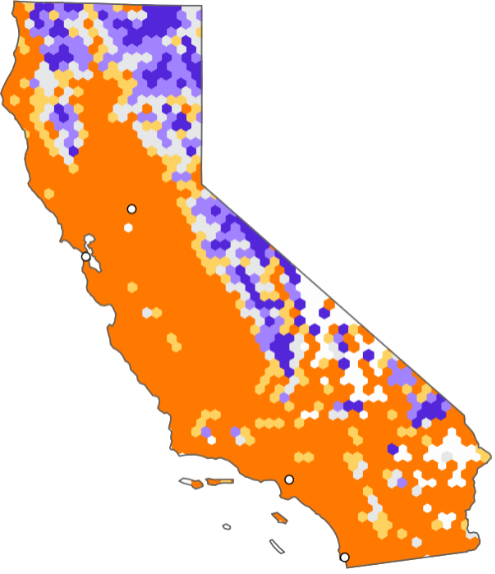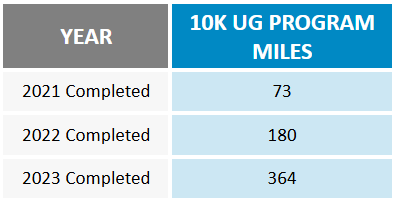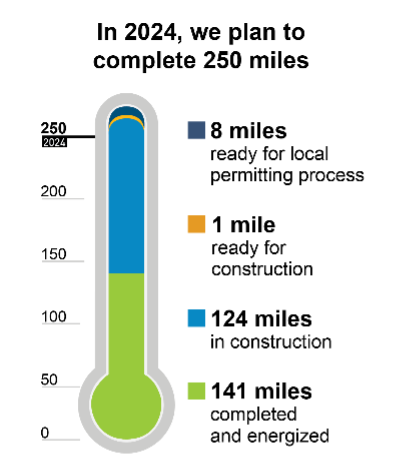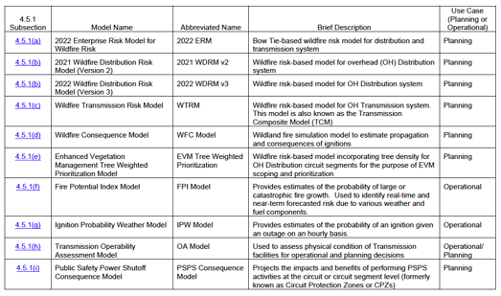Introduction
Pacific Gas and Electric (PG&E), one of the largest utility companies in the United States, serves over 16 million people across Northern and Central California. As a critical provider of energy, PG&E faces unique challenges due to the region’s susceptibility to wildfires exacerbated by climate change, drought, and aging infrastructure. Over the past decade, PG&E has played a pivotal role in addressing the state’s escalating wildfire crisis, often grappling with the repercussions of equipment-related ignitions. In response, the company has initiated transformative programs such as its Undergrounding Program, aiming to reduce wildfire risk and improve the safety and reliability of its electric grid. Through innovative technologies and adaptive strategies, PG&E strives to balance public safety, environmental preservation, and cost efficiency while navigating complex regulatory and operational landscapes.
Climate Change and the Evolution of Wildfire Risk in California
Using various types of statistical models and projected climate scenarios, studies in the early 2000s predicted that wildfires in California were set to increase in both frequency and intensity.[1] Westerling et al. (2006) suggested that the reason for this was due to higher temperatures and lower precipitation increasing fuel flammability.[2] Unfortunately, these predictions proved to be accurate: since the 1970s, wildfire extent in California has increased fivefold, and is only getting worse (Fig. 1).[3] Intensities have increased dramatically in recent years, with fires such as the 2018 Camp Fire destroying over 10,000 acres of vegetation and land in just 90 minutes.[4] Ten years after Westerling et al. (2006) and Westerling & Bryant (2007) linked climate change to California wildfires, scientists are continuing to develop conclusive links between human-mediated climate change and wildfires.[5] For example, Williams et al. (2019) back up these predictions and state that increased atmospheric aridity caused by warming temperatures leads to fuel-aridity and increases in wildfire risk.[6] Precipitation decrease has continued to get worse, with periods of extreme drought increasing since 2013 (Fig. 2).

https://earthobservatory.nasa.gov/images/148908/whats-behind-californias-surge-of-large-fires

While there are natural causes of wildfire that have been occurring long before humans inhabited Earth, an overwhelming majority of wildfires in California have been linked to human causes[7] (Fig 3). A recent study by Turco et al (2023) found that anthropogenic climate change burns areas 172% larger than natural wildfires.[8] One human-driven cause of wildfires can be overhead powerlines. These lines can ignite nearby vegetation if they fall and can be especially dangerous during periods of extreme weather such as drought and wind. Even a single spark over dry vegetation, caused by strong winds blowing debris into multiple conductors, can trigger short circuits and release hot particles as current flows through.[9] In combination with unnaturally high temperatures and drought increasing ignition risk and arid fuel area, wildfires pose one of the greatest threats to California’s citizens, environment, and wildlife. However, undergrounding power lines can nearly eliminate wildfires caused by power lines, with Pacific Gas and Electric (PG&E) suggesting that underground powerlines reduce wildfire risk by 98% compared to overhead powerlines in a given location.[10] Technology like protective covers, on the other hand, only result in a risk reduction of approximately 65%.[11]


Wildfire causes in California, 1992-2020
https://www.axios.com/local/san-diego/2023/08/24/california-wildfires-human-caused
PG&E’s Undergrounding Program as a Response to Evolving Wildfire Risk
In a recent report, PG&E found that between 2015 and 2022, 14 catastrophic wildfires were caused by failures in their equipment. It was in the wake of these devastating fires (including 2018’s Camp Fire) that PG&E announced the creation of their undergrounding program in 2021. This program has the highly ambitious goal of undergrounding 10,000 miles of their distribution lines, concentrated to areas with the highest wildfire risk.[12] This represents approximately one-third of the approximately 25,500 miles of electric overhead distribution lines that PG&E has located in high fire-risk areas. To reach this goal, PG&E has continued to ramp up undergrounding efforts, completing 73 miles of undergrounding in 2021, 180 miles in 2022 and 364 miles in 2023 (Fig. 4A).[13] Additionally, PG&E has plans to complete 250 miles of undergrounding in 2024 (Fig. 4B), 330 miles in 2025 and 440 miles in 2026. Plans for work beyond 2026 are also in development as a part of PG&E’s 10-Year Electrical Undergrounding Plan. All areas identified for undergrounding undergo a multi-step process including scoping, surveying, design, construction preparation, construction and post-construction cleanup (Fig. 4C).



Determining How to Eliminate Wildfire Risk from An Electric System
To effectively reduce wildfire incidence, PG&E has developed a thorough and extensive series of models such as an Enterprise Risk Model (ERM), a wildfire transmission Risk Model, a Fire Potential Index Model, and an Ignition Probability Weather Model (Table 1). For example, the 2022 ERM is a tool that was originally designed for General Rate Case (GRC) proceedings to evaluate various risks, including wildfire risks, for safety concerns. It uses a specific method called the Multi Attribute Value Function (MAVF) to measure risks before and after safety measures are taken. This helps compare risks across different areas in the company and figure out how efficient safety spending is for wildfire management programs. Overall, it looks at all risks in the company’s systems and assesses how well safety measures work.
One crucial model in this list is the Fire Potential Index (FPI) model that predicts the potential for catastrophic fires in PG&E’s service territory.[15] To create this model, PG&E developed partnerships with organizations DTN, Technosylva, Atmospheric Data Solutions, Sonoma Technology Inc. and San Jose State University to incorporate innovative machine learning methodology. The model’s core inputs are from weather forecasts as well as other data sources like topography and terrain-wind alignment, vegetation type (each with different ignition risks) and fuel moisture (Fig. 5). Essentially, the model learns from over 30 years of weather, fuel moisture, vegetation type, topography, and historical fire occurrence data at an hourly rate to make predictions about large fire growth under current and forecasted conditions.[16]
PG&E uses these data sources to prioritize their wildfire safety work, including undergrounding, and to target these efforts in areas at the highest risk of wildfire. They analyze wildfire risk by combining the probability of an ignition occurring at a particular location on their electric system and the consequences if a wildfire were to start in that location. They then develop workplans for improvements like undergrounding with the goal of addressing as much wildfire risk, as efficiently as possible.


PG&E’s Undergrounding Regulatory Process and Upcoming Milestones
2023-2026 Undergrounding Plans (General Rate Case)
Each large electric utility company in California must submit a General Rate Case (GRC) application with the California Public Utilities Commission (CPUC). This public proceeding sets the rates that a utility will collect from its consumers, with a major goal of ensuring that customer’s rates remain affordable. The GRC process involves public forums, hearings in which utilities testify before an administrative judge which are open to the public and supporting documents from the utility company. The judge’s proposed decision is then opened for public comment, followed by a vote by CPUC commissioners to either accept the judge’s proposal or vote to approve something different. The process is split into two phases: phase I which determines the total amount to be collected from customers by utilities, and Phase II which determines how those costs are shared among residential, commercial, and industrial customers.[17]
On June 30, 2021, PG&E filed its 2023-2026 GRC Application to underground 2100 miles of overhead lines between 2023-2026. This application came with a proposed average rate increase of $3.40/month due to costs associated with undergrounding electric lines and decreasing wildfire risk.[18] In September of 2023, Administrative Law Judges DeAngelis and Larson returned with a proposed decision (PD) of 200 miles of undergrounding and CPUC commissioner John Reynolds gave an alternate proposed decision (APD) of 973 miles of undergrounding with focus instead on covered conductors, Public Safety Power Shutoffs (PSPS), and Enhanced Powerline Safety Settings Programs (EPSS).[19] PG&E argued that despite the higher initial rate increase, costs would actually be lower over time because of reduced vegetation management costs, operation and maintenance costs, and potential damage from wildfires, which would also incur costs.[20] However, PG&E faced public pushback as California energy consumers experience some of the highest utility rates in the United States, with residential rates doubling since 2006.[21] Following a period of public comment, on November 16, 2023, the CPUC unanimously approved CPUC Commissioner John Reynolds’ revised Alternate Proposed Decision of installing 1,230 miles of underground electrical wires between 2023 and 2026.[22] This was a significant milestone on PG&E’s path toward undergrounding a substantial portion of its electric system in the highest wildfire risk area.
Long-Term Undergrounding Plans (10-Year Electrical Undergrounding Plan)
In March 2024, the CPUC launched a new undergrounding initiative just four months after approving PG&E’s 2023-2026 General Rate Case. This new effort, rooted in Senate Bill 884 (which passed in 2022), allows large electrical corporations to submit 10-year undergrounding plans for approval by the California Office of Energy Infrastructure Safety (OEIS) and California Public Utilities Commission (CPUC). Long-term plans of this nature will allow utilities to improve coordination with government agencies, vendors, customers and other stakeholders. In turn, this allows utilities to reduce costs related to undergrounding (driven by long term contracts and the ability to avoid costly delays) and allows utilities to more easily explore innovative undergrounding options. These plans will also undergo periodic audits for oversight.[23]
Senate Bill 884 mandates the CPUC and OEIS to establish an expedited utility distribution infrastructure undergrounding program. To participate, utility corporations must submit a 10-year plan addressing undergrounding projects prioritized by wildfire risk reduction, public safety, cost efficiency, and reliability benefits. The plan must also compare undergrounding with aboveground hardening for risk reduction and include a workforce development strategy and economic evaluations. Upon submission, the plan will begin an approximately 20-month public hearing process that will include review and approval by both Office of Energy Infrastructure Safety (OEIS) and the CPUC. Initial submission to OEIS is currently expected to take place in Mid-2025.
Once approved by OEIS, the large electrical corporation must submit the plan to the CPUC for cost review and conditional approval. The CPUC will consider the plan’s safety improvements, cost targets, and public comment before approving or requiring modifications. If approved, the corporation must report progress every six months, including work plans and annual wildfire mitigation filings. An independent monitor will also be hired to assess compliance. The monitor will submit annual reports to the office, and the office may recommend penalties to the CPUC for non-compliance. In addition to traditional funding sources for wildfire safety efforts, the law requires corporations to seek non-ratepayer funding to offset program costs.[24]
Utilizing Proven and Emerging Undergrounding Technologies
Considering PG&E’s ecologically and geologically diverse service area, different undergrounding methods (such as open-cut or trenchless digging) will need to be utilized depending on a project location’s terrain, vegetation, accessibility, and other preexisting underground utilities.[25] Difficult terrain in particular can result in significant undergrounding costs. PG&E’s Undergrounding Program is dedicated to achieving cost reductions by using a variety of construction methods and driving innovation. For example, today the program harnesses the following construction techniques tailored to specific soil types and terrain challenges for efficiency:
- Plow: Plows are efficient construction tools used in softer soil types over expansive and open land to bury cables without the need to create large trenches. This approach involves a machine creating a slot in the ground surface, potentially repeating this process multiple times in order to loosen dirt completely depending on the subsurface geology and the specified depth of the utility wire. The conduit, coiled on a reel at the rear of the machine, is fed through pulleys into the plow chute, where it is then placed into the bore slot. Plows therefore excel in quickly and cost-effectively excavating narrow pathways for cables, making them ideal for projects in areas with less challenging terrain.[26]
- Rock wheel: Rock wheels are indispensable in more rugged and rocky terrains where traditional excavation methods struggle. These specialized tools are designed to cut through rock formations with precision, allowing for the creation of pathways for cables even in the most challenging environments.[27]
- Chainsaw trencher: Like the rock wheel, chainsaw trenchers offer versatility in trenching through rocky terrain. Particularly suited for midsize pipeline installations, chainsaw trenchers work best on hard and abrasive surfaces.[28]
- Boring: Directional boring, AKA horizontal directional drilling, and auger boring are two methods that involve creating underground pathways for cables without trenching. This method is particularly useful in urban environments with limited space or areas with sensitive infrastructure above ground. Boring minimizes disruption to the surface while still allowing for the installation of cables.[29]
- Slinger truck: Slinger trucks are specialized vehicles equipped with conveyor systems that can accurately place materials such as backfill into trenches by using conveyer belt propulsion to launch materials with high precision. They are useful alternatives to traditional methods of backfilling that use loading trucks, which require significantly higher labor cost and time and are unable to fill hard to reach areas.[30]
- Volumetric mixer: Volumetric mixers are a type of concrete mixer that are used to mix concrete on-site using separate compartments for cement, sand, stone, and water. These mixers allow for precise control over the mix design and can adjust the concrete mix as needed based on project requirements, ensuring optimal performance and durability of installations.[31]
Refining Construction Approaches
In tandem with deploying advanced construction equipment, the program places significant emphasis on refining construction approaches to maximize efficiency and minimize costs. Central to this endeavor is the strategic design of narrower and shallower trenches, meticulously tailored to accommodate cable installation while minimizing excavation requirements. This approach not only reduces material and labor costs associated with trenching but also mitigates environmental disruption, preserving surrounding landscapes.[32] Furthermore, the program’s commitment to reducing the density of boxes per mile streamlines maintenance operations, minimizing logistical complexities and associated expenses.[33] By prioritizing the rightsizing of electrical infrastructure to suit the unique demands of diverse environments, from densely populated urban areas to remote rural locales, the program optimizes resource allocation and enhances cost-effectiveness across its operations.
New Technology – Ground Level Distribution Systems
An innovative aspect of the program involves the pilot testing of Ground Level Distribution Systems (GLDS) in areas where traditional undergrounding is not feasible. This may be true for culturally protected lands (such as land with indigenous significance), areas with contaminated soils where disturbing soils may be toxic to workers and the environment, and in areas with hard rock and granite where trenching is impractical. GLDS, as the name suggests, involves placing power lines directly on the ground and covering them with a specific type of concrete rather than burying them underground through trenching. This approach offers several potential benefits compared to traditional undergrounding methods. Firstly, it significantly reduces costs associated with trenching, spoil disposal, and restoration efforts. Secondly, GLDS installations can be deployed more quickly, making them ideal for urgent infrastructure needs. Additionally, the use of geopolymer concrete in GLDS installations provides fire-resistant properties, enhancing safety and durability. Overall, the innovative use of GLDS presents a promising alternative to traditional undergrounding methods in appropriate applications, offering cost-effective solutions with minimal environmental impact.
[1] Westerling, A. L., and Bryant, B. P. “Climate Change and Wildfire in California.” Climatic Change 87, no. S1 (2007): 231–249. https://doi.org/10.1007/s10584-007-9363-z.; Fried, Jeremy S., Margaret S. Torn, and Evan Mills. “The Impact of Climate Change on Wildfire Severity: A Regional Forecast for Northern California.” Climatic Change 64, no. 1 (2004): 169–191. https://doi.org/10.1023/B:CLIM.0000024667.89579.ed.
[2] Westerling, A. L., Hidalgo, H. G., Cayan, D. R., and Swetnam, T. W. “Warming and Earlier Spring Increases Western U.S. Forest Wildfire Activity.” Science 313, no. 5789 (2006): 940–943. https://doi.org/10.1126/science.1128834.
[3] Williams, A. Park, John T. Abatzoglou, Alexander Gershunov, Janin Guzman‐Morales, Daniel A. Bishop, Catherine J. Miller, and Dennis Fox. “Observed Impacts of Anthropogenic Climate Change on Wildfire in California.” Earth’s Future 7, no. 8 (2019): 892–910. https://doi.org/10.1029/2019EF001210.; NASA Earth Observatory. “What’s Behind California’s Surge of Large Fires?” https://earthobservatory.nasa.gov/images/148908/whats-behind-californias-surge-of-large-fires.
[4] NPR. “Climate Change Makes Wildfires in California More Explosive.” https://www.npr.org/2023/08/30/1196637141/climate-change-makes-wildfires-in-california-more-explosive.
[5] Williams, A. Park, John T. Abatzoglou, Alexander Gershunov, Janin Guzman‐Morales, Daniel A. Bishop, Catherine J. Miller, and Dennis Fox. “Contribution of Anthropogenic Warming to California Wildfires During 2014–2018.” Proceedings of the National Academy of Sciences 116, no. 44 (2019): 22488–22493.
[6] Williams, A. Park, John T. Abatzoglou, Alexander Gershunov, Janin Guzman‐Morales, Daniel A. Bishop, Catherine J. Miller, and Dennis Fox. “Observed Impacts of Anthropogenic Climate Change on Wildfire in California.” Earth’s Future 7, no. 8 (2019): 892–910. https://doi.org/10.1029/2019EF001210.
[7] California Department of Forestry and Fire Protection. “Fire Incidents.” https://www.fire.ca.gov/.
[8] Zhou, Shao, Patrick T. Brown, John T. Abatzoglou, and Steven J. Davis. “Overlooked Benefits of Vegetation Management in Reducing Wildfire Risks.” Proceedings of the National Academy of Sciences 120, no. 12 (2023): e2213815120. https://doi.org/10.1073/pnas.2213815120.
[9] San Diego State University. “Wildfire Research and Its Implications.” https://newscenter.sdsu.edu/sdsu_newscenter/news_story.aspx?sid=79257.
[10] CBS News. “PG&E’s Push to Bury Power Lines as a Wildfire Prevention Plan Faces Pushback over High Rates.” https://www.cbsnews.com/sanfrancisco/news/pge-bury-power-lines-wildfire-prevention-plan-pushback-high-rates-cpuc/#:~:text=PG%26E%20says%20burying%20a%20power,reduce%20that%20chance%20by%2062%25.
[11] Associated Press. “Pacific Gas and Electric’s Wildfire Mitigation Efforts.” https://apnews.com/article/pacific-gas-electric-pge-power-lines-california-d5ec49626164ce5cb68af12b9223c427#:~:text=PG%26E%20says%20burying%20a%20power,reduce%20that%20chance%20by%2062%25.
[12] ASCE Civil Engineering Magazine. “California Utility to Underground 10,000 Miles of Power Lines.” https://www.asce.org/publications-and-news/civil-engineering-source/civil-engineering-magazine/article/2021/09/california-utility-to-underground-10000-mi-of-power-lines#:~:text=In%20July%2C%20the%20Pacific%20Gas,at%20high%20risk%20of%20wildfire.
[13] Pacific Gas and Electric. “Community Wildfire Safety Program.” https://www.pge.com/en/outages-and-safety/safety/community-wildfire-safety-program/system-hardening-and-undergrounding.html#tabs-11859f9db6-item-6dc8f4f626-tab.
[14] California Office of Energy Infrastructure Safety, Pacific Gas And Electric Company 2023-2025 Wildfire Mitigation Plan, https://energysafety.ca.gov/what-we-do/electrical-infrastructure-safety/wildfire-mitigation-and-safety/wildfire-mitigation-plans/2023-wildfire-mitigation-plans/
[15] California Office of Energy Infrastructure Safety, Pacific Gas And Electric Company 2023-2025 Wildfire Mitigation Plan, https://energysafety.ca.gov/what-we-do/electrical-infrastructure-safety/wildfire-mitigation-and-safety/wildfire-mitigation-plans/2023-wildfire-mitigation-plans/
[16] T&D World. “PG&E’s Predictive Technology for Wildfire Prevention.” https://www.tdworld.com/wildfire/article/21266864/pges-predictive-technology-for-wildfire-prevention.
[17] YouTube. “PG&E Undergrounding Plans Explained.” https://www.youtube.com/watch?v=XRksVgvkc-Y.
[18]California Public Utilities Commission. “General Rate Case for Pacific Gas and Electric.” https://www.cpuc.ca.gov/industries-and-topics/electrical-energy/electric-rates/general-rate-case/pacific-gas-and-electric-grc-proceedings.; PG&E Currents. “PG&E Responds to Claims on Undergrounding Program Effectiveness.” https://www.pgecurrents.com/articles/3806-pg-e-responds-inaccurate-claims-cost-effectiveness-powerline-undergrounding-program-reducing-wildfire-risk.
[19]PG&E Currents. “PG&E Comments on CPUC Proposals for 2023–2026 General Rate Case.” https://www.pgecurrents.com/articles/3829-pg-e-comments-cpuc-proposals-2023-2026-general-rate-case.
[20] PG&E Currents. “Patti Poppe Makes the Case for Undergrounding Miles.” https://www.pgecurrents.com/articles/3837-patti-poppe-makes-case-undergrounding-miles-mercury-news.
[21] Associated Press. “PG&E’s Plan for Wildfire Mitigation.” https://apnews.com/article/pacific-gas-electric-pge-power-lines-california-d5ec49626164ce5cb68af12b9223c427.
[22] California Public Utilities Commission. “Prioritizing Safety, Reliability, and Affordability in PG&E’s Rate Case.” https://www.cpuc.ca.gov/news-and-updates/all-news/cpuc-prioritizes-safety-reliability-and-affordability-in-pge-rate-case-2023.
[23] Utility Dive. “California’s Undergrounding Program Update.” https://www.utilitydive.com/news/california-puc-power-line-undergrounding-program/709846/.
[24] California State Legislature. “Senate Bill 884.” https://leginfo.legislature.ca.gov/faces/billCompareClient.xhtml?bill_id=202120220SB884&showamends=false.
[25] ASCE Civil Engineering Magazine. “California Utility to Underground 10,000 Miles of Power Lines.” https://www.asce.org/publications-and-news/civil-engineering-source/civil-engineering-magazine/article/2021/09/california-utility-to-underground-10000-mi-of-power-lines#:~:text=In%20July%2C%20the%20Pacific%20Gas,at%20high%20risk%20of%20wildfire.
[26] Loy Clark Pipeline Co. “Cable Plowing Services.” https://www.loyclark.com/our-services/cable-plowing/.
[27] Plantforce. “Rock Wheels for Trenching.” https://plantforce.com/hire/explore-the-fleet/attachments/rock-wheels/.
[28] Tesmec. “Chainsaw Trenchers: 1150EVO.” https://www.tesmec.com/trenchers/products/chainsaw-trenchers/1150evo.
[29] Scenic America. “Case Study: Dominion Energy Undergrounding.” https://www.scenic.org/take-action/resources/undergrounding-resources-and-white-papers/case-study-dominion-energy/; Hadlee & Brunton. “What Is Horizontal Directional Drilling?” https://www.hadleeandbrunton.co.nz/what-is-horizontal-directional-drilling/.; Trenchless Technology. “Horizontal Directional Drilling vs. Auger Boring.” https://trenchlesstechnology.com/horizontal-directional-drilling-vs-auger-boring/.
[30] Cox and Cox Construction. “Slinger Trucks: Precision Placement.” https://coxandcoxconstruction.com/slinger-trucks/.
[31] For Construction Pros. “Volumetric Mixing Shapes the Backbone of the Bay Area.” https://www.forconstructionpros.com/concrete/equipment-products/concrete-mixers/article/21064873/volumetric-mixing-shapes-the-backbone-of-the-bay.
[32] Utilities One. “Key Differences Between Shallow and Deep Excavations.” https://utilitiesone.com/key-differences-between-shallow-and-deep-excavations.
[33] Scenic America. “Underground Cable Installation and Conduit Design.” https://www.scenic.org/take-action/resources/undergrounding-resources-and-white-papers/underground-cable-installation-and-conduit-design/.